

النبات

مواضيع عامة في علم النبات

الجذور - السيقان - الأوراق

النباتات الوعائية واللاوعائية

البذور (مغطاة البذور - عاريات البذور)

الطحالب

النباتات الطبية


الحيوان

مواضيع عامة في علم الحيوان

علم التشريح

التنوع الإحيائي

البايلوجيا الخلوية


الأحياء المجهرية

البكتيريا

الفطريات

الطفيليات

الفايروسات


علم الأمراض

الاورام

الامراض الوراثية

الامراض المناعية

الامراض المدارية

اضطرابات الدورة الدموية

مواضيع عامة في علم الامراض

الحشرات


التقانة الإحيائية

مواضيع عامة في التقانة الإحيائية


التقنية الحيوية المكروبية

التقنية الحيوية والميكروبات

الفعاليات الحيوية

وراثة الاحياء المجهرية

تصنيف الاحياء المجهرية

الاحياء المجهرية في الطبيعة

أيض الاجهاد

التقنية الحيوية والبيئة

التقنية الحيوية والطب

التقنية الحيوية والزراعة

التقنية الحيوية والصناعة

التقنية الحيوية والطاقة

البحار والطحالب الصغيرة

عزل البروتين

هندسة الجينات


التقنية الحياتية النانوية

مفاهيم التقنية الحيوية النانوية

التراكيب النانوية والمجاهر المستخدمة في رؤيتها

تصنيع وتخليق المواد النانوية

تطبيقات التقنية النانوية والحيوية النانوية

الرقائق والمتحسسات الحيوية

المصفوفات المجهرية وحاسوب الدنا

اللقاحات

البيئة والتلوث


علم الأجنة

اعضاء التكاثر وتشكل الاعراس

الاخصاب

التشطر

العصيبة وتشكل الجسيدات

تشكل اللواحق الجنينية

تكون المعيدة وظهور الطبقات الجنينية

مقدمة لعلم الاجنة


الأحياء الجزيئي

مواضيع عامة في الاحياء الجزيئي


علم وظائف الأعضاء


الغدد

مواضيع عامة في الغدد

الغدد الصم و هرموناتها

الجسم تحت السريري

الغدة النخامية

الغدة الكظرية

الغدة التناسلية

الغدة الدرقية والجار الدرقية

الغدة البنكرياسية

الغدة الصنوبرية

مواضيع عامة في علم وظائف الاعضاء

الخلية الحيوانية

الجهاز العصبي

أعضاء الحس

الجهاز العضلي

السوائل الجسمية

الجهاز الدوري والليمف

الجهاز التنفسي

الجهاز الهضمي

الجهاز البولي


المضادات الميكروبية

مواضيع عامة في المضادات الميكروبية

مضادات البكتيريا

مضادات الفطريات

مضادات الطفيليات

مضادات الفايروسات

علم الخلية

الوراثة

الأحياء العامة

المناعة

التحليلات المرضية

الكيمياء الحيوية

مواضيع متنوعة أخرى

الانزيمات
Flower Structure and Cross-Pollination
المؤلف:
AN INTRODUCTION TO PLANT BIOLOGY-1998
المصدر:
JAMES D. MAUSETH
الجزء والصفحة:
7-11-2016
3117
Flower Structure and Cross-Pollination
The production and development of spores, gametes, zygotes, and seeds are complex, elaborate processes, but they are not the only functions of flowers. Flowers are also involved in the effective dispersal of pollen and seeds. Because numerous mechanisms carry out these processes, numerous types of flowers and fruits exist.
CROSS-POLLINATION
Cross-pollination is the pollination of a carpel by pollen from a different individual; self-pollination is pollination of a carpel by pollen from the same flower or another flower on the same plant. In any plant population, there is genetic diversity. Random mutations will have produced some new genes that offer improved fitness and some that are deleterious. With cross-pollination, sperm cells and egg cells from different plants unite, resulting in new combinations of genes, at least a few of which may be better adapted than either parent. But self-pollination has about the same result as asexual reproduction because all genes come from the same parent. No possibility exists of bringing in new genes that might provide more fitness than those inherited from the parent. Many new plants may result, but none can be better adapted than the parent. However, if a plant is isolated by distance or lack of pollinators from potential cross-pollination partners, self-pollination allows it to set seed and propagate its genes rather than lose them when the plant dies.
Many mechanisms have evolved that decrease the probability of self-pollination and increase the chances of cross-pollination with its accompanying genetic diversity.
STAMEN AND STYLE MATURATION TIMES
Self-fertilization in flowers that have both stamens and carpels is prevented if anthers and styles mature at different times (Fig. 1). In many species, anthers release pollen while the stigma tissues are immature and unreceptive; the style may not have elongated yet, so the stigmas may be near the base of the flower while the anthers are at the top, elevated by elongated filaments. When the stigma and style become mature there may be no living pollen left in the flower, so all pollination is effected by younger flowers just opening their anthers. This is not a very effective means of ensuring cross-pollination. On plants with many flowers that do not open simultaneously, older flowers could be self-pollinated by freshly opened flowers of the same plant. Even if pollen does come from other plants, many of the near neighbors are probably closely related, because many of the seeds of a plant fall and germinate near the plant, producing a cluster of plants that are at least as closely related as first cousins.
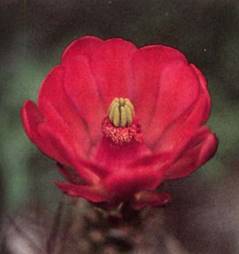
FIGURE 1:The stamens of this cactus flower are mature and shedding pollen, but the stigmas (green) are pressed together and are unreceptive. Later, the stamens wither and the stigmas spread open, ready to receive pollen from a different flower.
STIGMA AND POLLEN INCOMPATIBILITY
In many species, especially many important crop species, self-pollination is inhibited by compatibility barriers, chemical reactions between pollen and carpels that prevent pollen growth. In one incompatibility system, as a pollen tube grows, the stigma and style test proteins on the tube's surface; if one of these proteins is produced by a gene that matches an incompatibility gene in the carpel-bearing plant, the stigma and style block any further growth of the pollen tube. In self-pollination, all pollen tube genes match those of the stigma and style, and blocking occurs (Fig. 2).
In another common system, the critical proteins are deposited on the outer surface of the pollen grain by the anther. Any match of proteins produced by the incompatibility genes blocks germination of the pollen grain. The pollen tube-style interaction involvesa haploid genome (pollen tube) and a diploid one (carpel), whereas the second system involves two diploid genomes (anther and carpel). The diploid/diploid system involves twice as many genes, so it has a much greater probability of pollen rejection. With the diploid/diploid system, not only is self-pollination prevented, but inbreeding between close relatives is blocked as well.
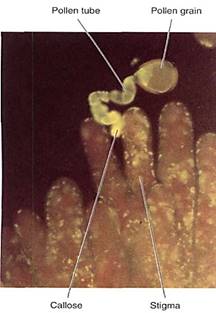
FIGURE 2: This pollen grain has started to grow on an incompatible stigma, but the stigma has blocked it, causing callose to form. The callose fluoresces in ultraviolet light, so it shines brightly in this micrograph (X 200). (Courtesy of J. B. and M. E. Nasrallah, Cornell University).
MONOECIOUS AND DIOECIOUS SPECIES
Among incomplete flowers there is a significant difference between flowers that lack sepals or petals and those that lack stamens or carpels. The latter two organs are essential organs because they produce the critically important spores; if either organ is absent, sexual reproduction is dramatically affected. Flowers that lack either or both essential organs are not only incomplete but also imperfect flowers. If a flower has both, it is perfect even though it may lack either sepals or petals or both. Sepals and petals do not produce spores and are considered nonessential organs.
It is necessary to consider the whole plant and the whole species as well as individual flowers. Stamens produce pollen that results in sperm production, and carpels are involved in egg production, so a species must have both types of organs. Plants that have perfect flowers satisfy this requirement. But if some flowers of the species are imperfect, having no stamens for instance, then other flowers must have stamens by being either perfect or by being imperfect due to lack of carpels. A large number of combinations is possible: A species may have individuals that produce only staminate flowers and others that produce only carpellate flowers—this is dioecy, and the species (not the flower or the plant) is said to be dioecious. Examples of dioecious species are marijuana, dates, willows, and papaya. In dioecious species, the life cycle actually consists of four types of plants: (1) microgametophytes, (2) megagametophytes, (3) staminate sporophytes, and (4) carpellate sporophytes.
Monoecy is the condition of having staminate flowers located on the same plant as carpellate flowers; monoecious species include cattails and corn—ears are clusters of fertilized carpellate flowers, and tassels bear numerous staminate flowers (Fig. 3). In some members of the cucumber family, the type of flower produced varies. Young plants and those growing in a poor environment produce staminate flowers, whereas older plants and those growing in a good environment produce perfect or carpellate flowers. If fertilization occurs, the carpels develop into large fruits, and only a healthy, robust plant can afford to do this. A young or poorly growing plant cannot supply enough carbohydrate and protein for fruit development, but it can supply enough to produce pollen.
Dioecy is an extreme adaptation that ensures cross-pollination; a plant that produces only one type of spore cannot pollinate itself. It is similar to the condition of separate sexes in mammals-no individual can fertilize itself. Both conditions ensure that fertilization is by sex cells that are not identical, thus increasing the genetic diversity of the offspring.
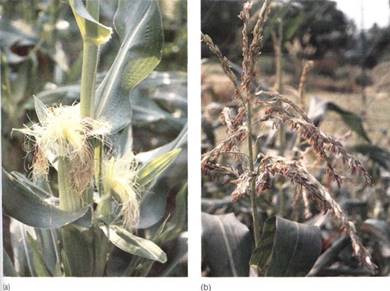
FIGURE 3 (a) Ears of corn are really large groups (inflorescences) of carpellate flowers surrounded by protective leaf-like bracts (the husks). The corn "silks" are long stigmas, (b) Corn tassels are inflorescences of staminate flowers.
ANIMAL-POLLINATED FLOWERS
The evolution of animal-mediated pollination had a dramatic impact on the evolution of flowering plants. In wind-pollinated gymnosperms, things such as brightly colored petals, fragrances, and nectar are a waste of material and energy. But once insects began visiting early angiosperms, mutations that resulted in pigments, fragrances, or sugar-rich secretions became adaptive. For pollen that is carried by wind, the probability that any particular grain will actually land on a stigma is very low, whereas if it is carried by an insect that flies from flower to flower, the probability of a pollen grain reaching a stigma is much improved.
When this insect-flower association began around 120 million years ago, neither insects nor flowers were particularly sophisticated. Insects probably visited all kinds of flowers, not recognizing the different species. As a result, pollen often landed on the stigma of the wrong species, where it was useless. Mutations that increased a plant's distinctiveness, its recognizability by an insect—flower color, size, shape, fragrances, and so on—became selectively advantageous. Rewards for the insect such as sugary nectar or protein-rich pollen and stamens were advantageous. Mutations were adaptive if they increased the capacity of insects to recognize flowers that offered abundant nectar or pollen. Because it is expensive energetically for an insect to fly, the ability to recognize the most nutritious flowers from a distance while flying is advantageous. As a result, many lines of insects and flowers underwent coevolution, a flower becoming adapted for visitation by a particular insect, and the insect for efficient exploitation of the flower. Coevolution has also occurred between flowers and birds and between flowers and bats.
The shape of the flower is particularly important, as a pollinator actually makes contact with it. Most flowers are radially symmetrical; that is, any longitudinal cut through the middle produces two halves that are mirror images of each other. These flowers are actinomorphic or regular (Fig. 9.27). But all insects, birds, and bats are bilaterally symmetrical -only one longitudinal plane produces two halves that are mirror images. In many species, flowers and pollinators have coevolved in such a way that the flowers are now also bilaterally symmetrical-zygomorphic (Fig. 4c). When a pollinator approaches a zygomorphic flower, only one orientation is comfortable for it; any misalignment prevents the pollinator's head or body from fitting the flower's distinctive shape. As a result, as the pollinator feeds at the flower, pollen is placed on a predictable part of its body. When it visits the next flower, pollen is rubbed directly onto the stigma. Not only is pollen carried to the appropriate flower, but it is carried directly to the stigmas. By contrast, a pollinator can approach an actinomorphic flower from any direction and pollen may be brushed onto any part of the body; when it visits the next flower, the pollen-carrying part may not come into contact with the stigmas and effect cross-pollination.
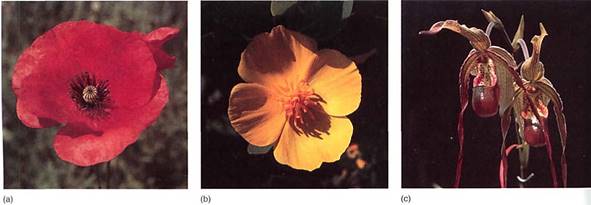
FIGURE 4: (a) Any median longitudinal section of this poppy results in two halves that are mirror images of each other; it is radially symmetrical, that is, actinomorphic. (b) Dendromecon is also radially symmetrical. (c) This orchid flower is bilaterally symmetrical, zygomorphic; only if cut from top to bottom are the two halves mirror images. A pollinator, also bilaterally symmetrical, fits well only if it approaches the flower properly. (Courtesy of Todd Barkman, University of Texas)
WIND-POLLINATED FLOWERS
In species that are wind-pollinated, a totally distinct set of modifications is adaptive. At tracting pollinators is unnecessary, so mutations that prevent the formation of petals are selectively advantageous, and the energy saved can be used elsewhere in the plant. Sepals are also often reduced or absent and the ovaries need no special protection, so the whole flower may be tiny. Zygomorphy provides no selective advantage. Once pollen is released to the wind, the chance of any particular pollen grain landing on a compatible stigma is small, so huge numbers of grains must be produced. Large, feathery stigmas are adaptive by increasing the area that can catch pollen grains (Fig. 5). In general, wind-pollinated individuals produce up to several thousand small flowers; although each flower is tiny, the entire plant has a large total stigmatic surface area.
Pollination is aided by the growth pattern of the plant population. Wind-pollinated species—like grasses, oaks, hickories, and all conifers—grow as dense populations in rangelands or forests. Within 1 km2 may be found thousands of plants and, more importantly, millions of stigmas. Species that occur as widely scattered, rare individuals must rely on animal pollination.
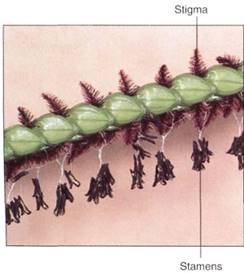
FIGURE 5:This is an inflorescence of St. Augustine lawn grass (Stenotaphrum secundatum); if lawns are mowed frequently, inflorescences and flowers are not seen. Like many wind-pollinated species, this has feathery, highly branched stigmas that catch wind-borne pollen. (James L Castner)
OVARY POSITION
The ovary and ovules must be well protected from pollinators. Paradoxically, a flower must bring a hungry animal to within millimeters of protein-rich ovules in order to effect pollination. Adaptations that maximize the separation are long styles and stamen filaments.
Burying the ovaries deep within the flower provides further protection. In some species, after all flower organ primordia are initiated at the receptacle apex, the primordia crowd together and the bases of the stamens, petals, and sepals fuse, creating a thick layer of protective tissues around the ovaries, which appear to be located below the other organs (see Figs.6 a and b). Two terms describe this: We can either say that the ovary is an inferior ovary or that the other parts are epigynous. Inferior ovaries also can result if, receptacle tissue grows upward around the ovary (Fig. 6c). The more common arrangement, in which no fusion to the ovary occurs and the ovary is obviously above the other flower parts, is a superior ovary or hypogynous parts. Intermediate, partially buried ovaries are half-inferior with perigynous flower parts.

FIGURE 6: (a) In flowers with superior ovaries, carpels sit above the other organs, as would be expected because they are initiated last by the flower apical meristem. (b) This is an inferior ovary resulting fim the fusion of the bases of sepals, petals, and stamens to the base of the carpel. Four appendages are involved whose vascular bundles (dashed lines) are still present and distinct, (c) In some species, after all the appendage primordia are initiated, the receptacle tissue grows upward and surrounds the ovaries. This can be detected because the vascular bundles around the ovary are receptacle bundles, not appendage bundles.
 الاكثر قراءة في مواضيع عامة في علم النبات
الاكثر قراءة في مواضيع عامة في علم النبات
 اخر الاخبار
اخر الاخبار
اخبار العتبة العباسية المقدسة

الآخبار الصحية















 قسم الشؤون الفكرية يصدر كتاباً يوثق تاريخ السدانة في العتبة العباسية المقدسة
قسم الشؤون الفكرية يصدر كتاباً يوثق تاريخ السدانة في العتبة العباسية المقدسة "المهمة".. إصدار قصصي يوثّق القصص الفائزة في مسابقة فتوى الدفاع المقدسة للقصة القصيرة
"المهمة".. إصدار قصصي يوثّق القصص الفائزة في مسابقة فتوى الدفاع المقدسة للقصة القصيرة (نوافذ).. إصدار أدبي يوثق القصص الفائزة في مسابقة الإمام العسكري (عليه السلام)
(نوافذ).. إصدار أدبي يوثق القصص الفائزة في مسابقة الإمام العسكري (عليه السلام)


















